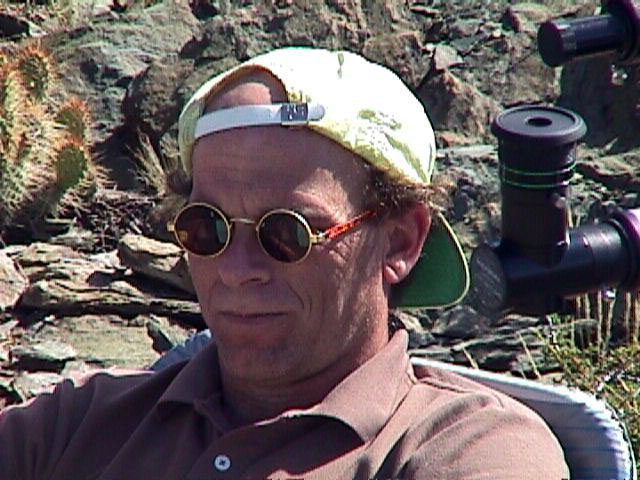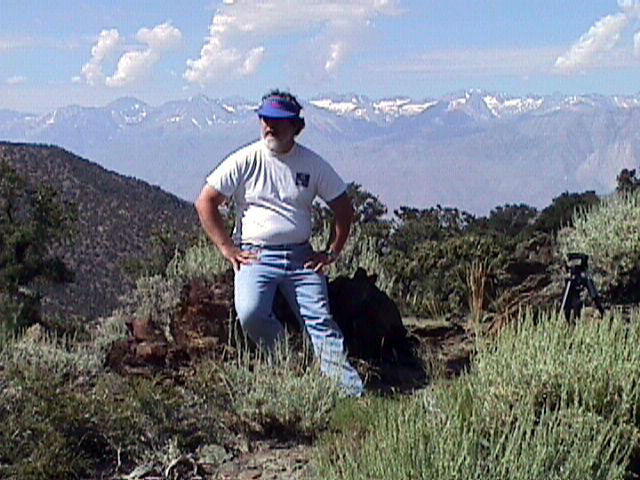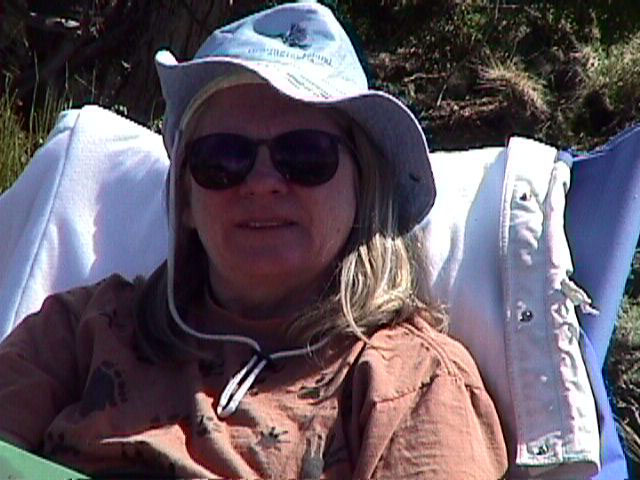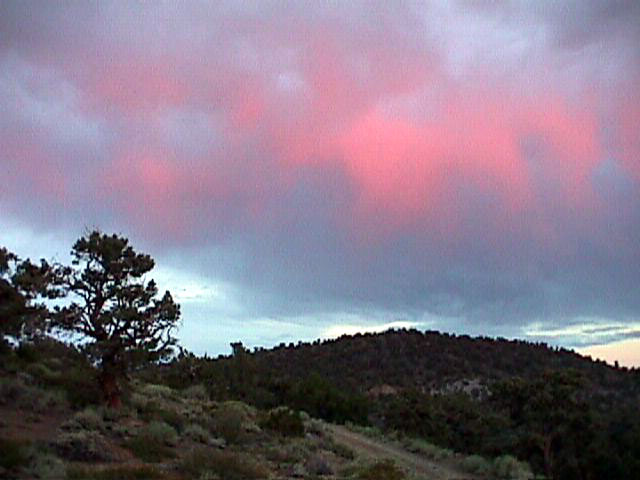 Far away from San Jose.
Far away from San Jose.
 Far away from San Jose.
Far away from San Jose.
 The Phoenix Section of Ptolemy's Supper Club (with Bill represented by his better half).
The Phoenix Section of Ptolemy's Supper Club (with Bill represented by his better half).
 Beneath that veil of simplicity, she secretly covets fancier toys.
Beneath that veil of simplicity, she secretly covets fancier toys.
 Mr. Cool meets the Panoptic 15.
Mr. Cool meets the Panoptic 15.
 Oh no, Mr. Bill! Do I really look like that?
Oh no, Mr. Bill! Do I really look like that?
 How she puts up with all this, I'll never know.
How she puts up with all this, I'll never know.
 "Sigh. All those years spent in Delaware when I could have been here."
"Sigh. All those years spent in Delaware when I could have been here."
 Not good astronomy weather but...
Not good astronomy weather but...
 ...you gotta love it anyway.
...you gotta love it anyway.
It's high. It's dark. It rained.
Long version:
It rained the day we arrived (Fri) and was cloudy into the evening. We optimistically set up some of our scopes anyway. We got a few pretty big sucker holes for a while before it clouded over again about midnight. We were at about 8800 ft, near Grandview campground. The sky was pretty dark, at least as good as Lassen, maybe better but it was a little hard to tell since we could only see part of the sky at once. There was a little light pollution in the west from BIshop but it wasn't bad and would have been much less if not for the clouds. Friday evening the seeing was pretty good, better than the average FPK, better than last year at Lassen, not quite as good as the best night I've had right here in my backyard. (I wish I could be more objective about this.)
My main worry prior to the trip was of being cold. But it turned out to be quite warm. There was little to no wind. I was in shorts most of the time even at night. (I suspect this is not altogether typical, however; the clouds kept it relatively warm.)
Thru the holes, we saw a bunch of the bright spectacular stuff. Most impressive to me was M17, the Swan/Omega/Checkmark/Horseshoe/Lobster Nebula. It was easily the equal of what I remember from last year at Lassen but still greatly enhanced by an O-III filter. The Veil, too, was impressive with lots of fine detail visible with the O-III. M15 looked more like M13 usually does :-)
We gave up about midnight but left everything set up. Early in the morning I woke up (because the damn bugs made sleep nearly impossible since I stupidly didn't set up our tent) and took a peek at Jupiter and the Moon. By then the seeing was superb. Jupiter was equal to the best I've ever seen (my previous best was just a few days ago right here in my backyard!). There was lots of activity in the SEB near the GRS, lots of "barges" on the north side of the NEB and lots of other fine detail, too. Some detail was visible in the GRS itself, or rather I should say that the GRS seemed to occupy only about the southern half of Red Spot Hollow. But this was by far the best view I have ever had of the Moon. I could have counted dozens of craterlets in Clavius. I saw three in Plato (some were already in shadow). Rima Birt was a huge wide gash running at least twice as far as I had previously seen. Even Vallis Schroteri, far from its optimal sun angle, was more distinct than I had previously seen. The color of the "continent" near there was obvious.
Saturday morning we had some nice views of sunspots. We saw what might have been a flare, a pair light regions near the umbra of one of the spots which lasted for a few hours then disappeared.
Saturday afternoon it rained. Much of our camping gear got wet. The sky didn't look very promising even after the rain stopped. We were bummed. We gave up.
I will try the White Mountains again. I think we had VERY unusual weather. At least it was warm (too warm for hiding from bugs in a down sleeping bag :-( We got about half of an average year's rainfall in the two days we were there. Since no one really knows why, I blame it on El Nino :-)
I had wanted to go much higher than the 8800 ft we eventually settled on. One can camp just north of the protected area at about 11500 ft. But it was probably a good thing that we stayed relatively low since none of us were acclimated and some were feeling a little bad even at 8800. High dry places are the best for astronomy but not for your brain. A day at moderate elevation before going on up may be required for most of us.
(For the record, it took just over six hours from here to there counting gas and food stops. Coming home was only a little slower, mostly because of traffic.)
Since the weather reports were calling for clearing Saturday night (and since I already had the time slated) I decided to stay and see what would happen. This in spite of the fact that my sleeping bag was wet and my tent was put away. I ultimately "slept" in my car much as I do at FP
As the Sun began its final 15 degree descent, the sky started opening up in all directions except toward the Sierras. A plane went over with no contrail whatsoever. At sunset it even looked as if even the Sierra clouds were moving out and breaking up. But as punishment for this gift the wind was picking up and was a bit cool (big surprise that this should happen after a low pressure system).
About the time I got everything running and aligned, and mounted the camera for some piggyback shots, a blob of clouds moved in (actually, it just "appeared") over my target. Harumphhh! So I went to another target and took a picture. Before I could get a second shot off in the same vicinity, a blob of clouds chased me from that location, too. In fact everywhere I pointed the camera seemed to generate more clouds (I'm considering sending the camera to NOAA for study).
By 10:15 I was down to a single sucker hole in the high South, and I spotted a "seven second blipper" satellite moving through it. It was totally black for 6.99 seconds and then a mag-2 blip before the cycle repeated. It was hardly making any progress WRT the background stars, but was moving.
Anyway, I decided to doze in my "bino chair" with hopes that things would
blow away. I woke up 35 minutes later (shortly before 11) and it was
totally clouded.
It took me 20 minutes to shut down, put away, cover my scope, climb into
the car, remove my contact lenses, and get the excess observing clothes
off. When I finally got around to placing my head on the pillow, I glanced
up out of the car window and...
Contacts back in, clothes back on, power up the scope, and resume gawking
and taking pictures. Views of everything were fantastic. And as an added
bonus the breeze had calmed down to practically nil.
Even at low power I was seeing much more detail on Jupiter than usual (and
it seemed much bigger than usual, too; I suspect this was because I was so
much closer to it at 8800 feet ;) At high power it was an awesome
spectacle. The GSfkaR looked like an eye--all white with a little circle
of color low in the middle. There were many bands in both the N and S. In
the area from the second band above the NEB to the N pole it was one
uniform shade of "dingy gray"; VERY strange looking. I hope my pictures
come out OK.
I observed and took wide-angle pictures for a couple hours, but
unfortunately I had to pack it in earlier than I would have liked; I was
just too sleepy after a long day and had a lot of driving to do in the
morning. (Oh, and as for temperature, it was still 49 degrees outside in
the morning even without the cloud cover.)
The next time I go there, I hope to be able to stay for more than just two
days. And hopefully it won't be an off-season monsoon season!!
I forgot to mention... there were quite a few Perseids still around.
Nice, bright-green streaks with lingering trails (lasting 1+ second).
I know it may sound goofy, but I count this trip as a success. We got out
of the city and got a few hours of astronomy. The good-stuff/driving ratio
may not have been the greatest but the drive wasn't bad anyway, at least
the half eastward of the Sierra foothills.
I must admit I was feeling the altitude a little while I was sitting in the
car during the rain on Sat. But there may have been other factors at work,
too (poor circulation in the car, hunger, some anxiety). I'm glad, though,
that we didn't go up higher as I had wanted. It seemed to me that Joan and
Dave would have been very uncomfortable at best. Next time we try for
something that high we might want to take a day to acclimate first.
We might not be able to plan and execute this year, but next year for
sure. I think I could have managed 10K this time if that had been the sole
target (taking it easy, decent weather, etc) but what I saw of the spots
above the Ranger Station tell me White Mtns is not the place for that. In
fact, we may have already found the best seats in the house (the one search
I wanted to do didn't get done; simply going further down the road we were
on. But I consider that site the prime location for now...)
BTW: looks like no optical damage to the C8. Collimation is out, focuser
acts a little weird (I think I can adjust that out) and Ak did a masterful
job of repairing the finder (bracket is a total loss... big whoop).
Bill again:
Joan and I left shortly after Dave/Akkana did. We went to Mammoth for
dinner/sleep and drove home Sunday. We went via Hwy 108/Sonora Pass, the
next one north from 120/Tioga Pass. Very nice. Got home in time for some
chores :-)
Dave:
I agree. You're right about acclimation, but I'm taking another tack: I'd
like to try your high altitude experiment. In other words, I'd like to spot
a place that has a good 11K or so and take something small and mobile, and
work a plan to see what it's like to get way up there and look at the sky.
12K might be too much, but I'm game.
Bill Arnett; last updated:
2003 Jan 1